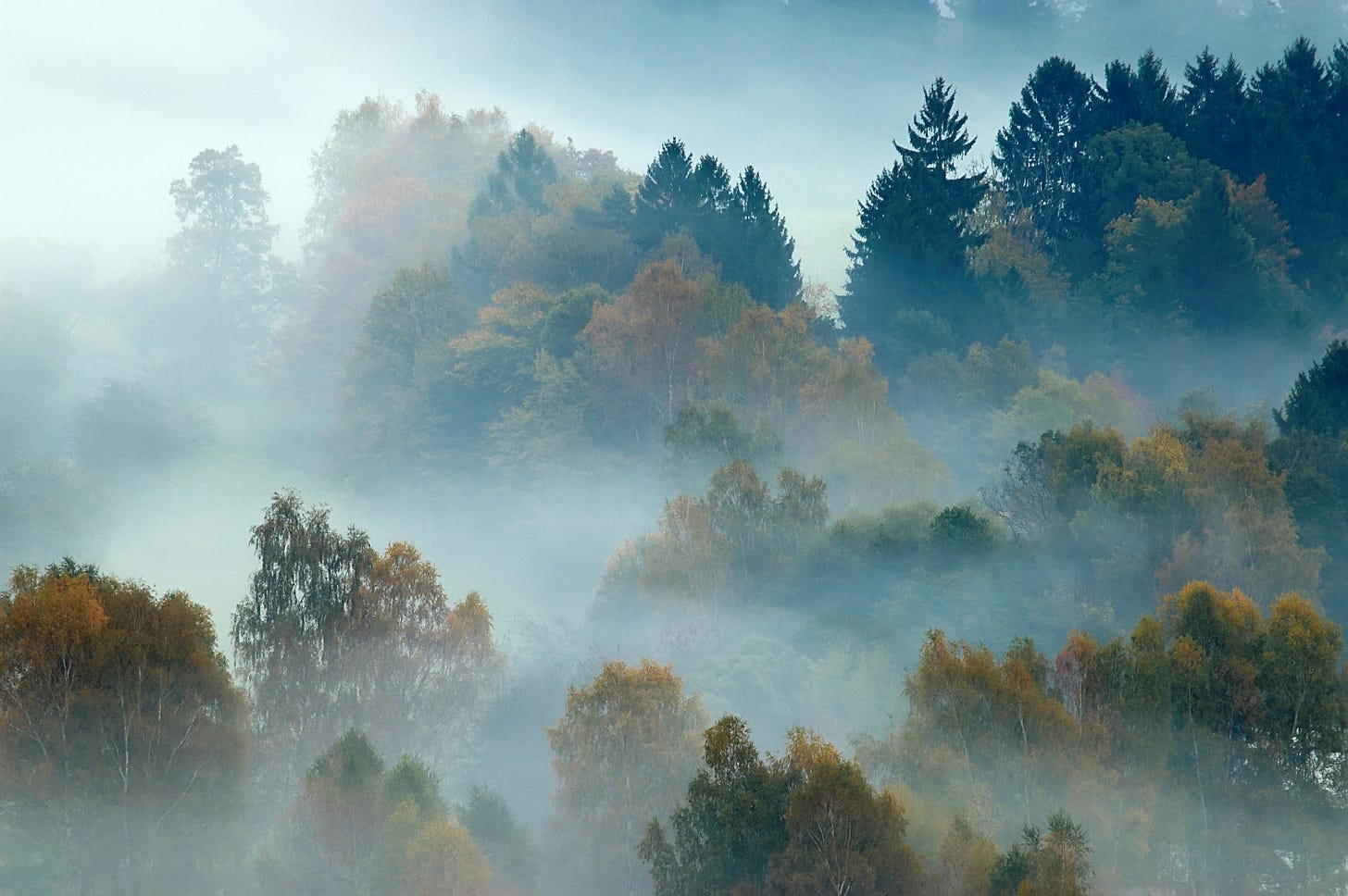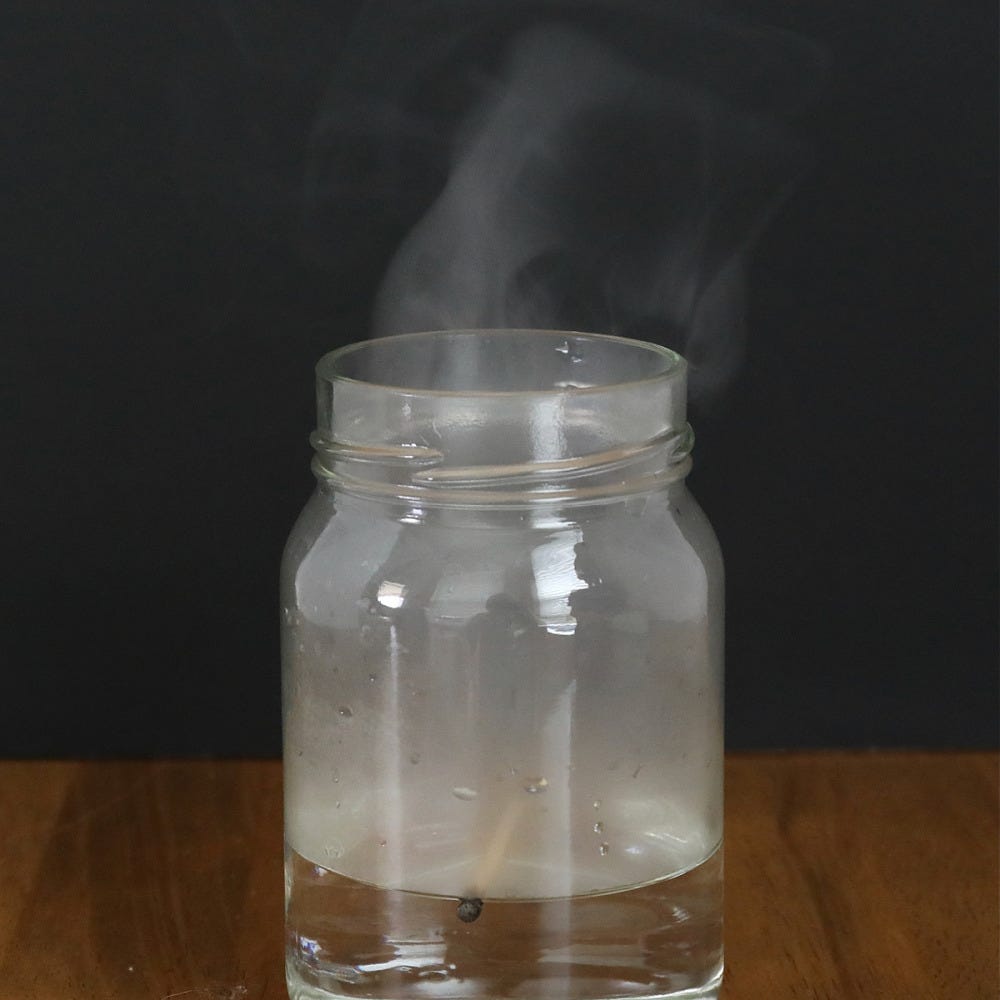Fog and Mist
How Science and Story Help Us See When Seeing Is Hard
Dear Parents, Grandparents, and Teachers,
In these Notes I write directly to you because I hope to awaken the wonder within. G.K. Chesterton reminds us: “The world will never starved for want of wonders, but only for want of wonder.”
If we say that nature study is “good for children” without entering into it ourselves, the experience becomes thin and dutiful. But, when wonder takes root in our own hearts, it naturally overflows to our children. They catch it from us more surely than from any lesson plan. True wonder begins with noticing—with allowing ourselves to be surprised, delighted, and humbled by the world God has made.
—
Today, I would like to turn to something elemental and mysterious: fog and mist.
I remember many early mornings driving to the school where I taught, the road wrapped in dense fog that made every mile perilous. I leaned forward, straining to see ahead, stomach tight and jaw clenched—alert for the sudden shape of a car, or worse, a person, emerging from the mist.
I didn’t like it—at all.
And yet, strangely, I love fog. I love its veils swirling about me. I love my clothes being wet and heavy with droplets. I love the wonder rising in me when sunlight pierces the mist, burning away the shroud and revealing a world made new—as if it were the first day of creation and I was there.
Fog and mist are like that—unsettling us, stirring foreboding, and filling us with awe. Why do they hold such power? To find out, I had to go back to basics.
What is fog and mist?
The Earth’s Breathing
Fog happens when warm air cools and tiny drops of water hang in the air. It helps keep plants safe from cold, slows down drying, and even gives trees a drink when rain is scarce. In places like California, the giant redwoods sip water straight from the fog. It’s almost like the earth is breathing—sending out a soft mist at night and drawing it back again in the morning.
The Mystery of Fog
As adults, we are uneasy with fog. We prefer things plain and open to our senses. Fog muffles sound and unsettles us with what might be hidden. It transforms the familiar into something strange—the road shortens, trees loom suddenly, even a porch light burns with an odd, otherworldly glow.
Children, though, slip into wonder. They sense at once that fog is marvelous, like stepping into a fairy tale where shapes shift and the ordinary world is enchanted. Where we resist fog’s uncertainty, they welcome its mystery. Perhaps if we entered fog as they do—with trust and curiosity—we might find ourselves surprised by wonder too.
Is the Fog Rising or Settling?
When you see fog draped across the landscape, you may wonder—has it risen from the earth, or has it drifted down from the sky? The truth is a bit of both, and that’s part of its mystery.
At night, as the ground cools, warmth seeps upward and the air near the surface condenses into fog. It settles low, slipping into valleys and hollows, a soft blanket laid across the earth. By morning, as sunlight warms the land, the fog begins to stir. What once gathered downward slowly lifts, thinning into air, vanishing like breath.
So the next time you see fog lingering among the trees, pause. Notice how it clings to the low places, how it rises in shimmering veils as the day brightens. Fog is the earth’s way of reminding us that even the air has rhythms of rest and rising, concealment and revealing.
Is Fog Mist?
Yes and no.
Fog and mist are both made of tiny droplets of water floating near the ground, but they differ in how much of the world they hide. Mist is the gentler of the two, a soft veil through which you can still see the outlines of trees and fences, more than a kilometer away. Fog wraps the landscape so closely that distant shapes vanish, and the air itself feels heavy and damp.
Both are born of the same breathing of the earth—moist air cooling against the ground—but where mist drifts lightly and soon lifts, fog lingers, pooling in hollows and valleys, turning the familiar world into something hushed and hidden.
And now we come a back to the question of why these twin elements have such a hold on our imagination.
We see mist and fog as mysterious, veiled, even otherworldly. But why?
Part of the answer lies in our senses. Fog softens edges, muffles sound, and bends light; it transforms what is familiar into something strange—even threatening. On a foggy morning, the world feels both closer and farther away. That sensory disorientation awakens in us an awareness of otherness.
A Lantern in the Mist
Poets and writers have known and written about this otherness. Charles Dickens saw dense fog descending on London like a judgment, blind to the needs of the poot. Conan Doyle used fog as a literary device to foreshadow trouble. T. S. Eliot said that fog (The Love Song of J. Alfred Prufrock) was like a yellow cat rubbing its sides against the window panes and licking the corners of the streets.
Then, there is the Nobel Prize winning Irish poet, Seamus Heaney—whom I admire immensely. Heaney sets a lantern alight in the mist and fog to help us find our way.
In The Haw Lantern he writes:
The wintry haw is burning out of season,
crab of the thorn, a small light for small people.
The lantern here is the hawthorn berry (haw), a red flame glowing against the gray mist in winter. Heaney notices its paradox: fruiting “out of season,” a sign that something in the natural order has shifted. Yet, in that bleak season—the Ireland of the Troubles—this lantern becomes a beacon. Not a blazing torch, not a floodlight, but a flicker, just enough “to keep the wick of self-respect from dying out.”
Elsewhere, Heaney describes:
…the mist we walked through lit by torches,
uncertain light, a promise half-hidden.
Here, fog becomes a liminal space, a threshold of revelation—a promise of things not yet revealed, of truths waiting to be born.
A lantern glowing in fog, a berry shining in winter, a torch glimmering through the mist—all remind us that mystery is the place where even the faintest light takes on the weight of glory.
What Fog Teaches Us About Seeing
Fog and mist can feel two ways at once—sometimes like a soft secret, sometimes a little scary. That’s the way nature often is. It isn’t only “good” or “bad,” but full of both beauty and caution. When we notice both sides, we can learn to love and respect the world God has made.
Like Heaney learn that fog, offers us a mirror that throws us back on ourselves. The real world is still present even when we cannot see it clearly.
Fog points beyond itself, hints at transcendence—something out of the reach or deeper than what we can measure. When we share this wonder with our children, we help them see that the world is layered with meaning. It will help them when they encounter their own ambivalence about fog and mist, as I did.
Activity: Fog in a Jar
You can see fog but you can also touch, observe, and even re-create it. All you need is a glass jar, some hot water, and a few ice cubes.
First, pour a little hot water into the jar and swirl it around, as if you were warming a teacup for a guest. The jar gets cozy and begins to breathe out invisible vapor.
Next, place a small lid or plate with ice cubes on top of the jar. Cold air now sits above the warm air, just like the sky does over the earth at night.
If you want, strike a match, blow it out, and drop the tiny wisp of smoke inside before covering it. Those little smoke particles give the fog something to cling to, just as real fog clings to dust in the air.
Now wait and watch. Slowly, a silvery mist curls up inside the jar. It swirls and drifts, just like the fog that gathers in valleys at dawn.
You’ve made your own fog—right at home. A reminder that even the air has secrets, and that wonder can be caught in something as simple as a jar.
Poem: Fog
Carl Sandburg’s “Fog” first appeared in Chicago Poems (1916). Inspired by Japanese haiku he was carrying in his pocket, Sandburg jotted it down on scrap newsprint while waiting for a judge in Chicago—calling it his own “American haiku” after seeing fog drift over the harbor.
Fog
The fog comes
on little cat feet.
It sits looking
over harbor and city
on silent haunches
and then moves on.
Ask your child: “Show me with your body how the fog-cat comes, sits, and then moves on.” And, then: “What did it feel like to move like the fog-cat?”
At the end of your poetry time, you can say: “And just like the fog-cat, our poem has curled up and moved on.”
Do you have a fog story?
Do you have a fog story of your own? I’d love to hear it. Share it below and let us glimpse how fog or mist has touched your life.
Gratefully,
Sheila Carroll
Living Books Press





This is lovely. Thank you for writing! It's been years since I did nature study with my students, but what a wonderful reminder to get out and do it myself—and to read poetry again!
Love what you said here, “Fog is the earth’s way of reminding us that even the air has rhythms of rest.”
But I sure don’t like driving in it!